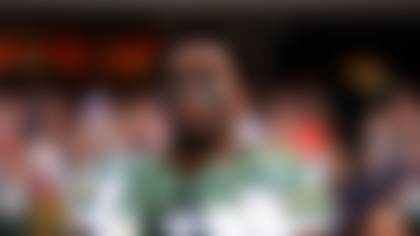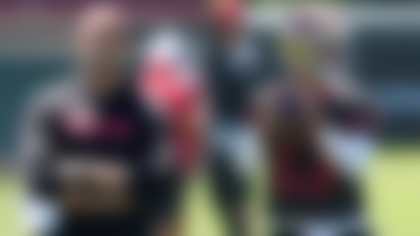New technology always has a way of presenting new challenges.
Bugs must be eliminated. Comfort levels must be found. Venting must be done.
Ever been foiled while trying to place a call or send a text or get an e-mail on that cutting-edge cell phone you just had to have? Ever consider throwing it against the wall or out the window?
Now you have an appreciation for the feelings that defensive coaches and players have experienced while getting their chance to try out the helmet-communication technology this summer previously limited to the offensive side of the ball.
How difficult has the transition been for some teams?
New England Patriots coach Bill Belichick has told reporters that he and other coaches with whom he has spoken are fully prepared to use hand signals, which was what defensive coaches once used exclusively to deliver alignments and coverages to defenders on the field during a game. Although quarterbacks have been able to hear plays from coaches through their helmets since 1994, the defense was left in the stone ages.
Until now.
This year, for the first time in NFL history, defensive coaches will have the help of the microphone attached to their headset and a speaker mounted in the helmet of a player (most likely a middle or inside linebacker) on the field designated to relay the signals to the rest of the defense. It is part of the fallout of the Patriots' videotaping scandal, a way to eliminate the ability to steal hand signals, as the Pats were caught and punished for last season.
When the equipment works properly, it represents a significant improvement over the hand-signaling. Coaches and players mostly agree that there is no better way to communicate than by speaking directly into one's ears. A coach can offer his on-field signal-caller far greater detail with words than with hands, make late call changes more efficiently, point out offensive substitutions that can be more easily detected from the coaches' booth, and reminders about down and distance.
"I'm loving it, I'm loving it," San Diego Chargers defensive coordinator Ted Cottrell said. "The thing I've noticed about it is that you're able to get your calls in a couple of seconds quicker. And it gives our defensive guys a couple seconds' head start on what they're supposed to do."
"It works well," said Tampa Bay Buccaneers defensive coordinator Monte Kiffin. "We like it."
However, Kiffin wouldn't go as far as to predict that the technology will produce better results for the Bucs' traditionally strong defense.
"You've still got to tackle," he said. "A walkie-talkie can't make the tackle."
And when the equipment fails -- and it has for several teams on several occasions during training-camp practices and preseason games -- those destructive urges can take over. During camp, the system cut out enough times to plant a seed of doubt in the mind of the player who wears the speaker helmet for the Chargers, linebacker Matt Wilhelm.
During one Green Bay Packers practice, coach Mike McCarthy intentionally and abruptly shut down the communications systems on both sides of the ball and pumped in artificial crowd noise so that his coaches and players would revert to hand-signaling under the sort of challenging conditions they would face on the road.
Actually, that comes more naturally to those on the defensive side of the ball. Early in camp, Wilhelm drew some strange looks from teammates on the sidelines when they heard Cottrell's booming voice coming from the linebacker's helmet.
Besides ironing out some technological bumps, there are other issues that have cropped up. Among them:
» Some coaches have expressed concern that the violent collisions in which linebackers are regularly involved could cause equipment failure. As Tampa Bay's Jon Gruden points out, this happens from time to time with quarterbacks, but they generally are exposed to far fewer hits than linebackers. It was Gruden's frustration with periodic outages in the offensive communication equipment that partly caused him to oppose implementing it on the defensive side.
» The system figures to benefit some defenses more than others. For instance, a team such as the Patriots, which uses numerous sub-packages and gives opponents a variety of alignments and personnel groupings, will have a difficult time designating a player who will wear the helmet outfitted with the speaker. Clubs such as the Baltimore Ravens and Chicago Bears, whose schemes call for every-down middle linebackers, will have an easier time making use of it.
It would seem to make sense for the Pats to have their usual defensive play-caller, linebacker Tedy Bruschi, wear the device -- but he tends to come off the field on third down. The better choice would be a player likely to remain on the field for three downs. Linebacker Mike Vrabel, who can line up at multiple positions in New England's scheme, has worn it in the preseason, but there is no firm plan in place for him to wear it during the regular season. Perhaps a better three-down choice would be a cornerback. Belichick continues to take a "trial-and-error" approach to figuring out the best solution.
» Too much information. The system isn't perfect, even for a defense that has an every-down player receiving signals.
» The need to huddle. With hand signals, defensive backs could pick up the coverage from wherever they're standing. Now, they have to be in the huddle to hear what the signal-caller has to say based on the information he receives from the coach, and then run to their respective positions before the snap. That consumes more time and energy for players who usually run longer distances than everyone else on defense.
» Late substitutions. By rule, the headsets automatically shut off with 15 seconds remaining on the play clock, just as they do on offense. An offense can wait to make substitutions after that point, thus creating a formation or personnel grouping that could potentially render the defensive call made through the helmet moot. When that happens, defenses will go back to hand signals. In fact, the Chargers pretty much plan to use hand signals on every third down, when offenses are more likely to make late changes.
"You have to be on top of that," Kiffin said.
» Working with a delay. Just as with the offensive system, there is a delay between the time the coach speaks into his microphone and the defender hears him. That requires the coach to remember to hold down his talk button for a second before he speaks and keep it down until the player indicates whether he has heard the call with a thumbs up or a thumbs down.
» Correcting mistakes. The player who calls the signals on the field usually takes it upon himself to reprimand or correct players for mistakes. Sometimes he does it by yelling, sometimes by chasing down the player after a play and getting in his face. That's not always possible when he has to listen to the coach. Sometimes, it is necessary for the player to literally step out of the huddle, away from conversations taking place after the previous play, in order to hear the call.
Like it or not, the new technology is in place for this season. So are the new challenges.
It will take time for the skeptics to be convinced that making calls with your voice is better than making them with your hands -- if they can be convinced at all.
Even true-believers, such as Cottrell, are not ready to give up on the old-fashioned method.
"You're still going to need your hand signals," he said. "And the other thing that happens, we know, is that (electronic communications systems) do break down."
Have a question for Vic on anything NFL related? Send it to AskVic@nfl.com, and the best questions will be answered throughout the season on NFL.com.



